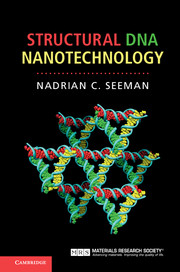Book contents
- Frontmatter
- Contents
- Preface
- 1 The origin of structural DNA nanotechnology
- 2 The design of DNA sequences for branched systems
- 3 Motif design based on reciprocal exchange
- 4 Single-stranded DNA topology and motif design
- 5 Experimental techniques
- 6 A short historical interlude: the search for robust DNA motifs
- 7 Combining DNA motifs into larger multi-component constructs
- 8 DNA nanomechanical devices
- 9 DNA origami and DNA bricks
- 10 Combining structure and motion
- 11 Self-replicating systems
- 12 Computing with DNA
- 13 Not just plain vanilla DNA nanotechnology: other pairings, other backbones
- 14 DNA nanotechnology organizing other materials
- Afterword
- Index
- References
3 - Motif design based on reciprocal exchange
Published online by Cambridge University Press: 05 December 2015
- Frontmatter
- Contents
- Preface
- 1 The origin of structural DNA nanotechnology
- 2 The design of DNA sequences for branched systems
- 3 Motif design based on reciprocal exchange
- 4 Single-stranded DNA topology and motif design
- 5 Experimental techniques
- 6 A short historical interlude: the search for robust DNA motifs
- 7 Combining DNA motifs into larger multi-component constructs
- 8 DNA nanomechanical devices
- 9 DNA origami and DNA bricks
- 10 Combining structure and motion
- 11 Self-replicating systems
- 12 Computing with DNA
- 13 Not just plain vanilla DNA nanotechnology: other pairings, other backbones
- 14 DNA nanotechnology organizing other materials
- Afterword
- Index
- References
Summary
We now know how to design sequences that should be pretty good at leading to a particular motif. We have studied extensively how to make a branched junction with a number of arms, and how to prevent branch migration in one. In this chapter, we are going to discuss several different routes to designing motifs to use as the basis for making objects, lattices, and devices. The key concept in designing motifs is the notion of reciprocal exchange. This is a process found within biological systems, but we are going to approach it somewhat differently: we are not actually going to perform reciprocal exchange in the laboratory, but merely on paper. We will then use the sequence-selection procedures of the preceding chapter to make the strands that will come together to form the motifs we design.
The notion behind reciprocal exchange is shown in Figure 3-1. The left side of the drawing shows two strands, a red strand and a blue strand. Following reciprocal exchange, we see on the right side a red–blue strand (going from upper left to lower right) and a blue–red strand (going from upper right to lower left). Thus, we still have two strands, but now they are each a mixture of the two strands we had before. We mentioned in Chapter 1 that the strands of DNA have a chemical polarity, called 5′ to 3′ polarity, so that one end of a strand is called the 5′ end and the other end is called the 3′ end. Following the reciprocal exchange shown in Figure 3-1, the red–blue strand contains the 5′ half of the red strand and the 3′ half of the blue strand, while the blue–red strand contains the 5′ half of the blue strand and the 3′ half of the red strand. Resolution in this context means that the crossover is cut and we go back to two juxtaposed bulges or hairpins. This is an idea that derives from recombination chemistry, where crossovers are resolved in one direction or the other to yield different products (e.g., see reference 3.2).
So far, this is just a formalized concept. It would probably help to see what happens in the context of a double helix.
- Type
- Chapter
- Information
- Structural DNA Nanotechnology , pp. 28 - 43Publisher: Cambridge University PressPrint publication year: 2016



